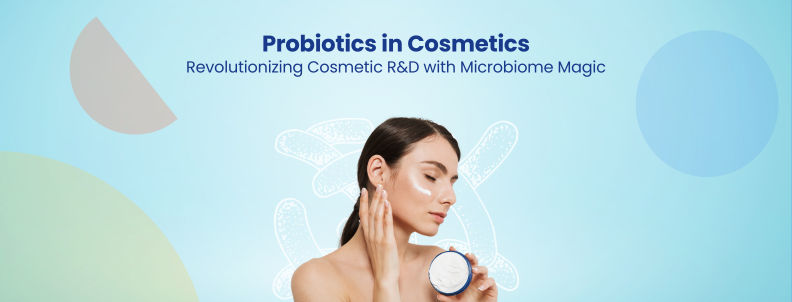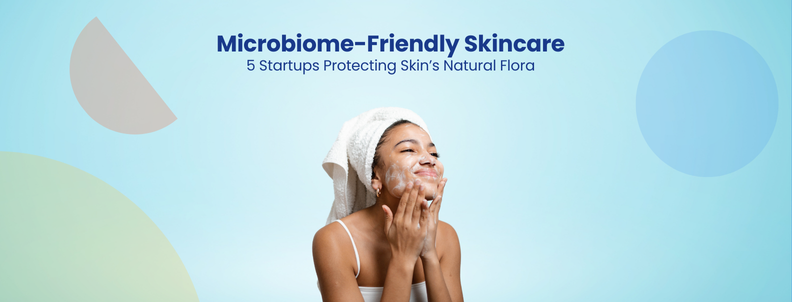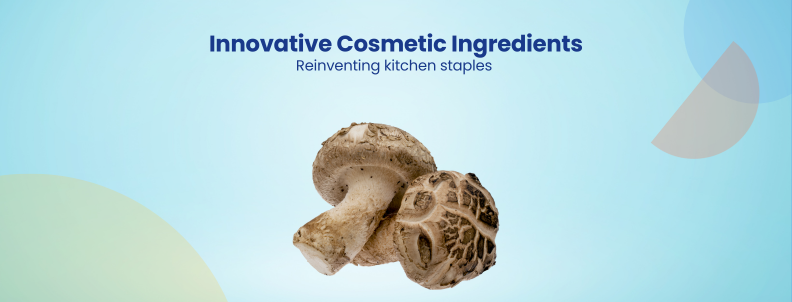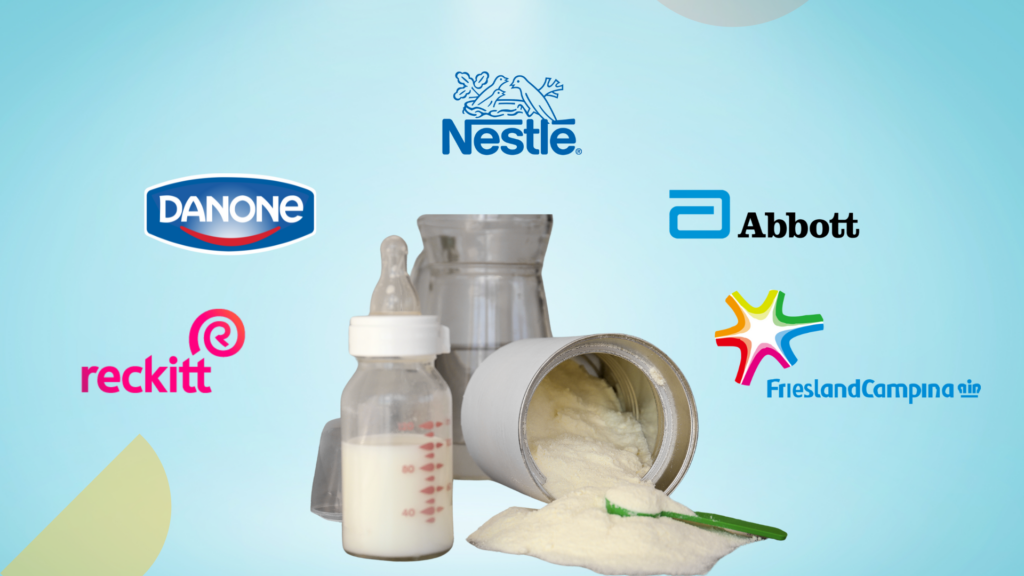The human skin is teeming with a diverse world of microorganisms, collectively known as the microbiome. This invisible ecosystem is crucial in maintaining skin health, influencing everything from barrier function to inflammation and sensitivity. In recent years, researchers have unlocked the hidden potential of this microbial community, paving the way for a revolutionary approach to skincare: probiotics.
This article delves into the exciting world of probiotics in cosmetics, exploring their potential applications, regulatory considerations, and future directions for R&D.
Market Growth and Factors
The market for probiotic cosmetic products is projected to expand significantly, with its valuation estimated at USD 16.42 billion in 2024 and anticipated to reach USD 21.67 billion by 2029 with a CAGR of 5.71%.
This growth is largely driven by the demand for natural cosmetics, especially among millennials, and the increasing popularity of probiotics as a key functional ingredient in addressing various skin concerns such as acne, wrinkles, and blemishes. This trend is expected to fuel market expansion throughout the forecast period.
This increasing demand prompts conventional manufacturers to incorporate more natural components into their products. One such component, probiotics, is forecasted to influence future product launches, indicating a significant shift in the industry’s ingredients and product development approach.
Interested in Cosmetic Innovation Trends in 2025? Download the report by filling out the form below:
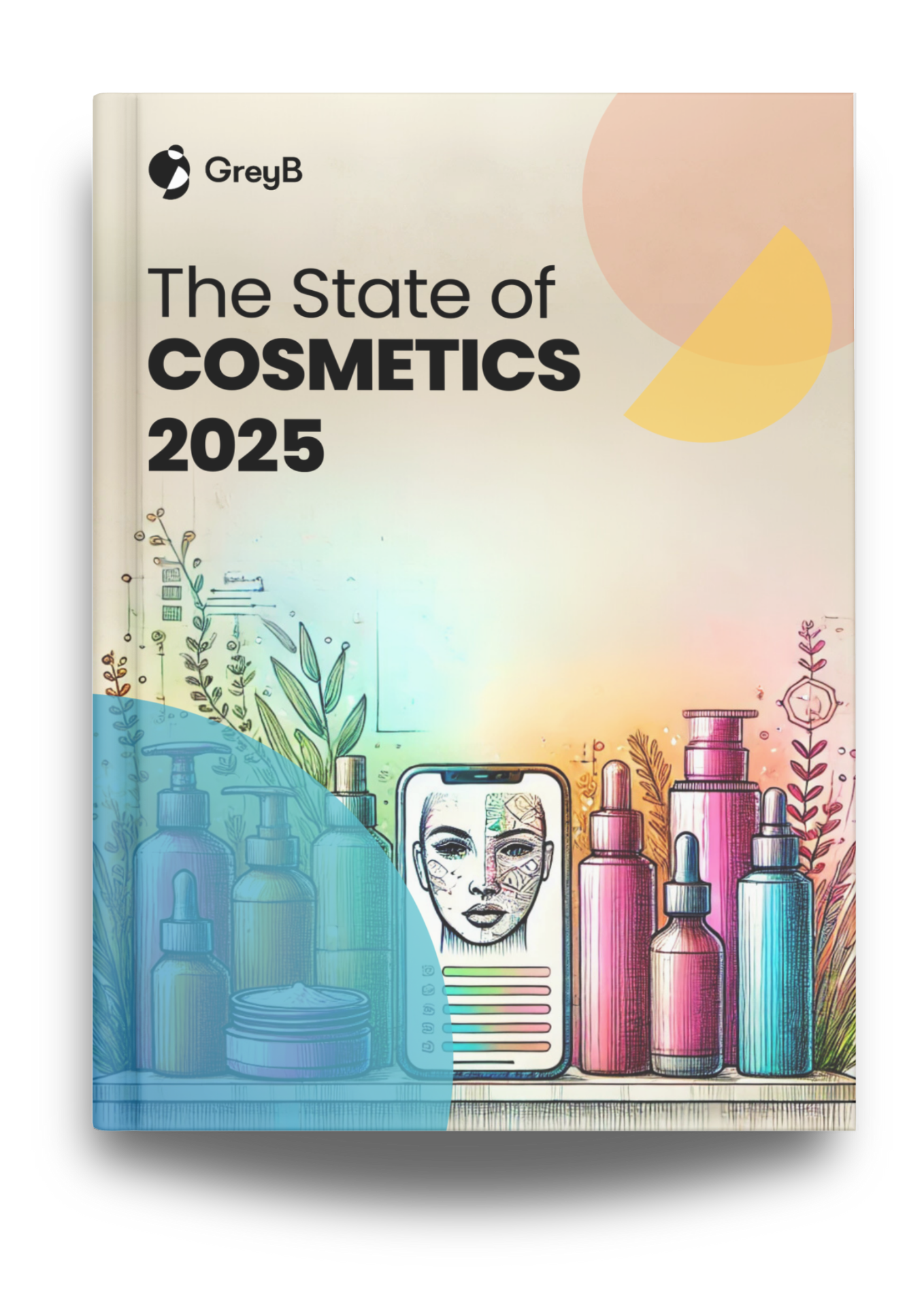
Applications of Probiotics in Cosmetics
Further research explores the use of targeted probiotics for specific skin concerns, like acne and eczema, and even anti-aging. Advances in probiotics encapsulation technologies and delivery systems offer exciting avenues for maximizing its efficacy and stability.
Probiotics for Anti-Aging
The pursuit of ageless beauty takes a revolutionary turn with probiotics, emerging as powerful allies in the fight against wrinkles, dryness, and photoaging. While time inevitably leaves its mark, harnessing the potential of the skin microbiome unlocks a treasure trove of anti-aging benefits.
Aging manifests in two primary forms. The first, Natural Aging, is driven by internal factors like genetics and telomere shortening, resulting in subtle lines and loss of skin elasticity. The second, photoaging, is the harsh hand of ultraviolet radiation accelerating skin aging. The latter contributes to wrinkles, pigmentation, and even skin cancer. This villain disrupts the skin’s microbiome, raises pH levels, and triggers harmful free radical production.
Combatting the effects of UV rays, probiotics offer a multi-pronged approach:
Hydration & Barrier Restoration: Dryness often plagues aging skin due to a weakened epidermal barrier. Probiotic strains like Streptococcus thermophilus S244 and Streptococcus salivarium spp. stimulate skin-hydrating enzymes, while oral probiotics like Bifidobacterium breve and Lactobacillus plantarum effectively reduce water loss and boost hydration.
According to a study, researchers found that Heat-Killed Lactobacillus L-137 (HK L-137) emerges as a promising agent for improving skin moisture retention by stimulating HA (hyaluronic acid) production by activating immune cells.
IFN-γ, a pro-inflammatory cytokine, plays a pivotal role in this process, collaborating with TNF-α, another pro-inflammatory cytokine, to orchestrate the upregulation of HA synthesis. This opens doors for future research exploring HK L-137’s potential in skincare and its contribution to maintaining healthy, hydrated skin.
Studies reveal that heat-inactivated Lactobacillus plantarum L-137 (HK L-137) effectively boosts skin cell hyaluronic acid production, a key molecule for plumpness and wrinkle reduction.
Ceramide Boost: Ceramides, vital components of the skin’s protective barrier, decline with age. Probiotic preparations like Streptococcus thermophilus and ultrasonic therapy can significantly increase ceramide levels, enhancing skin barrier function and elasticity.
Antioxidant Defense: Free radicals, the malicious byproducts of metabolism and environmental stressors, wreak havoc on skin cells, contributing to wrinkles and age spots. Probiotics like heat-killed Lactobacillus acidophilus KCCM12625P (AL) regulate reactive oxygen species (ROS) and matrix metalloproteinases (MMPs), both culprits in skin aging. Similarly, heat-killed Lactobacillus rhamnosus (RL) exhibits antioxidant and anti-melanin properties, promising for anti-aging and anti-photoaging cosmetics.
Collagen & Elastin Replenishment: Age depletes collagen and elastin, the crucial protein fibers providing the skin with a youthful bounce. Probiotics can support their production. Research suggests that combining β-Nicotinamide Mononucleotide (NMN) with Lactobacillus fermentum, TKSN041 enhances skin antioxidant enzyme levels and reduces UV-induced damage, paving the way for firmer, younger-looking skin.
Extracellular Vesicles: These tiny packages secreted by bacteria contain potent bioactive compounds contributing to skin health. Studies highlight the anti-aging properties of extracellular vesicles produced by L. plantarum, including inhibiting MMPs and elastase activity, improving elasticity, and even enhancing filaggrin production, all essential for maintaining a strong and supple barrier.
Combating Age-Related Pigmentation: Hyperpigmentation and uneven skin tone are common aging concerns. Probiotics like L. plantarum SM4 biotransformation offer a unique weapon in this battle, inhibiting melanin production while enhancing UV-A absorption, protecting the skin from further sun damage, and promoting a clear, radiant complexion.
Research continues to unveil the vast potential of probiotics in anti-aging skincare. From targeted strains for specific concerns to innovative encapsulation technologies for enhanced stability and delivery, the future of cosmetics lies in harnessing the power of the skin microbiome.
Probiotics for Natural Skin Brightening
Melanin, the pigment responsible for skin color, plays a fascinating dual role. While it protects from harmful UV rays, its uneven distribution can cause hyperpigmentation and concerns about dark spots and uneven tone. Luckily, the burgeoning world of probiotic research offers a natural, microbiome-friendly approach to skin brightening.
Unveiling the Tyrosinase Tamer
Melanin production hinges on an enzyme called tyrosinase. Probiotics can potentially become powerful skin-brightening agents by inhibiting this key enzyme. Lactic acid, a natural component of Lactobacillus acidophilus (LAB), and supernatants from specific probiotic strains effectively suppress tyrosinase and melanin synthesis.
Research suggests that a metabolite called phenylacetic acid, found in probiotic culture mediums rich in phenyl lactic acid, further hinders melanin production.
The Melanin Meltdown
Unlike other skin-whitening compounds that simply block melanin production, Kimchi-derived Staphylococcus lactis PMC48 holds the potential to both prevent and remove existing melanin. This powerful probiotic strain inhibits melanin production by targeting tyrosinase. It can degrade and eliminate pre-existing melanin from the skin, offering a two-pronged approach to skin brightening.
Lipoteichoic Acid: A Multi-Tasking Brightener
Lipoteichoic acid, a component of the cell wall of gram-positive bacteria like L. plantarum, packs a punch beyond skin hydration. Studies reveal its effectiveness in reducing tyrosinase activity, making it valuable in cosmetic skin-brightening formulations. Lipoteichoic acid from L. plantarum GMNL6 further bolsters its anti-melanin credentials, offering a natural and gentle approach to evening out skin tone.
A Brighter Future
Creams enriched with L. plantarum have notably improved skin hydration, tone, and spot reduction. They also show promise in tackling wrinkles, UV-induced pigmentation, and even porphyrin syndrome.
The potential of Staphylococcus sphaerus extract, another anti-melanin agent, adds to the arsenal of probiotic brighteners. Its ability to reduce pigmentation induced by melanocytostimulus signifies its role in promoting a more radiant and even complexion.
The beauty of probiotics lies not only in their effectiveness but also in their synergy with the skin’s natural microbiome. By fostering a healthy balance of these microscopic residents, we can unlock a natural glow from within, leaving harsh chemical interventions behind. As research continues to unveil the vast potential of probiotics in skin-brightening, one thing is clear: the future of a radiant and even complexion lies in harnessing the power of the microbiome.
Innovative Startups in Cosmetics
Probiotics in Anti-Inflammatory Cosmetics
The bustling world of our skin microbiome holds the key to maintaining a healthy, balanced complexion. But sometimes, unwanted invaders disrupt this equilibrium, leading to inflammation, irritation, and even chronic conditions like eczema and acne. This is where the valiant squad of topical probiotics steps in, ready to defend your skin and restore its natural harmony.
The Anti-Inflammatory Cavalry
Topical probiotics aren’t just bystanders; they actively produce antibacterial and anti-inflammatory substances, keeping harmful pathogens at bay and preventing opportunistic microorganisms from taking hold. Studies have shown their effectiveness in combating a range of skin woes, including:
Rosacea is a chronic inflammatory condition that often manifest as redness, bumps, and visible blood vessels. Research suggests topical probiotics like Lactobacillus and Bifidobacterium can calm the inflammatory response, leading to a calmer, more even complexion.
Atopic Dermatitis, characterized by dry, itchy patches and inflamed skin, thrives on an imbalanced microbiome. Enter the probiotic reinforcements! Extracellular vesicles from L. plantarum have been shown to prevent skin inflammation, while heat-treated Lactobacillus johnsonii NCC 533 (HT La1) helps keep the enemy, Staphylococcus aureus, in check.
Acne is created by a perfect mix of oily skin, clogged pores, and bacterial imbalances. Topical probiotics like L. plantarum produce antimicrobial peptides that act as your skin’s internal shields, defending against acne-causing microorganisms. And for an extra punch, ceramide from S. thermophilus offers antibacterial and anti-inflammatory properties, aiding in the fight against blemishes.
Benefits Beyond
The benefits of topical probiotics extend far beyond battling inflammation. They can also:
Boost the Skin’s Barrier: Bacterial lysates, generated by certain probiotics, can improve the function of the stratum corneum, the outermost layer of the skin. This strengthened barrier removes moisture and irritants, leading to healthier, more resilient skin.
Modulate the Immune System: Probiotic strains like Lactobacillus, Bifidobacterium, and Streptococcus have been shown to positively influence the skin’s immune response, promoting healthier skin overall.
The potential of topical probiotics in skin health is truly exciting. With ongoing research and development, we expect to see even more innovative probiotic-based solutions for maintaining a vibrant, balanced complexion. From acne-fighting heroes to rosacea-soothing allies, these microscopic champions are revolutionizing how we care for our skin, promoting health and beauty from within.
Probiotic Fermentation
The world of fermentation is no longer confined to sourdough starters and Kombucha. In the realm of skincare, it’s become a potent force, unlocking the hidden potential of botanicals and transforming them into potent allies for healthier, younger-looking skin.

Fermentation: Nature’s Supercharger
This ancient process doesn’t just add a tangy twist to your food; it unlocks a treasure trove of beneficial properties. Friendly bacteria like Lactobacillus and Bifidobacterium break down plant ingredients, making them more bio-available and enhancing their antioxidant and anti-aging powers. This translates to:
Boosted Effectiveness: Think of fermentation as putting your skincare on steroids. Acanthopanax Korean root, for example, explodes with antioxidant activity after a good microbial workout, offering enhanced protection against free radicals and environmental aggressors.
Enhanced Absorption: Fermentation breaks down complex molecules, making them easier for your skin to absorb. This means the goodies packed inside these botanicals reach deeper levels, maximizing their impact.
Reduced Toxicity: Fermentation can often mitigate potential irritants in plants, making them gentler on even the most sensitive skin.
The Botanical Arsenal
Fermentation is a versatile process, enchanting various botanicals, each unveiling its distinct advantages:
Jasmine Extract: This fragrant flower gets a longevity upgrade through fermentation. The process slows down collagen breakdown, helping your skin hold onto its youthful bounce.
Blackberry: This antioxidant powerhouse gets even punchier with fermentation. It delivers a double whammy of anti-aging and skin-lightening benefits thanks to its enhanced ability to combat damaging free radicals and uneven pigmentation.
Lavender: Known for its calming aroma, lavender’s fermented form packs an anti-aging punch. It helps protect against environmental aggressors and promotes cell regeneration, keeping your skin fresh and vibrant.
Pomegranate: This ruby-red fruit, already famed for its antioxidants, unlocks its full potential through fermentation. It fights free radicals, promotes collagen production, and boosts natural glow.
Rhodiola Rosea: This adaptogen extraordinaire harnesses the power of fermentation to combat stress and fatigue, both major contributors to skin aging. It helps your skin bounce back from environmental challenges and maintain a healthy, radiant appearance.
The Power of By-Products
The magic doesn’t stop with the fermented botanicals themselves. The by-products of this natural alchemy, called fermentation supernatants, hold their own secrets to a beautiful complexion. Take the Lactobacillus rhamnosus LRH113 strain, for example. Its fermentation supernatant shows promise in whitening and moisturizing skincare products, offering a potent and gentle solution for uneven skin tone and dryness.
By harnessing the power of friendly bacteria to unlock the hidden potential of nature’s bounty, researchers can create powerful, natural solutions for a healthier, more radiant complexion.

Startups Researching Probiotics For Cosmetics
Here are 4 startups currently researching probiotics in cosmetics:
1. AOBiome
AOBiome is known for pioneering research into using live ammonia-oxidizing bacteria (AOB) in skincare products. Through its brand, Mother Dirt, it has been exploring the potential benefits of AOB in promoting healthier skin microbiomes and addressing skin conditions.
AOBiome’s unique approach involves harnessing beneficial bacteria to restore balance to the skin’s microbiome, potentially improving skin health and appearance. They have developed products like AO+ Mist that contain live AOB.
2. TULA Skincare
The TULA Skincare brand incorporates probiotics, including strains like Lactobacillus and Bifidobacterium, into its formulations. It focuses on products that nourish and balance the skin’s microbiome.
Its unique selling point lies in using specific probiotic strains alongside other natural ingredients to create gentle skincare products on the skin and promote a healthier complexion.
3. Gallinée
Gallinée specializes in skincare products that contain prebiotics, probiotics, and postbiotics. Their research explores how these ingredients can help support and strengthen the skin’s microbiome.

Source: Gallinee
Its emphasis on postbiotics (metabolites produced by probiotics) sets them apart. They aim to harness the benefits of postbiotics to soothe, protect, and improve the skin’s texture and appearance.
4. Aurelia Probiotic Skincare
Aurelia Skincare’s research leverages unique probiotic extract technology, probiotic peptides, and bifida to advance skincare. Their distinctive probiotic extract technology is designed to soothe the skin’s natural immune responses that can be triggered by pollution and stress.

Source: Aurelia London
Probiotic peptides target the skin’s extracellular matrix, enhancing the production of collagen and hyaluronic acid.
Additionally, they incorporate bifida to optimize the skin’s innate repair mechanisms, aiding in reducing and reversing cellular damage. Collectively, these approaches contribute to Aurelia Skincare’s mission of promoting healthy and rejuvenated skin.
What to Expect Next?
The horizon of cosmetics is poised for a remarkable transformation with the continued exploration of probiotics and their derivatives. As we delve into the future, it becomes increasingly evident that probiotics are set to revolutionize the beauty and skincare industry.
Research and development efforts will soon lead to the creation of innovative probiotic-based skincare formulations, offering personalized solutions and clinical validation. Sustainability will become a priority, and probiotics will expand into ingestibles and supplements, thanks to collaborative research efforts between cosmetic companies, research institutions, and academia.
Conclusion
The popularity of probiotics in cosmetics is evident in the surge of everyday skincare products infused with these microbial marvels.
However, it’s important to note that most of these products contain non-living components like bacterial cell walls and inert bacteria due to regulations on live organisms in cosmetics.
To unlock probiotics’ full potential, R&D teams are experimenting with innovative approaches. One strategy involves incorporating prebiotics—”food” for probiotics—such as oligosaccharides and fructooligosaccharides. These prebiotics create a favorable environment for the growth of beneficial bacteria, fostering a balanced and healthy skin microbiome.
Besides R&D, the potential regulatory challenges for probiotics in cosmetics include proper labeling and marketing standards, FDA concerns regarding efficacy and safety, international regulatory variations, and the ongoing evaluation of safety data. Addressing these challenges will be crucial for effectively regulating probiotics in the cosmetics industry.
How Can We Help You?
We support industry-leading R&D and Innovation professionals through complex problems. Describe your challenge, and let us bring clarity and expertise.
Authored By – Vipin Singh, Marketing

